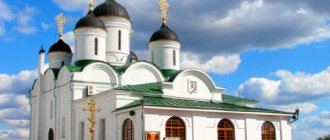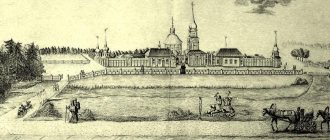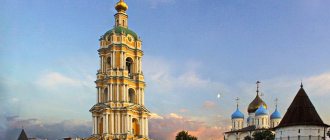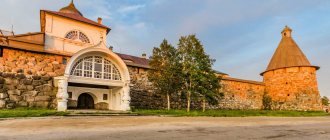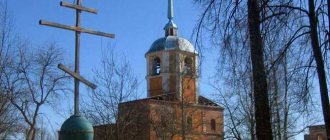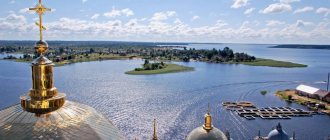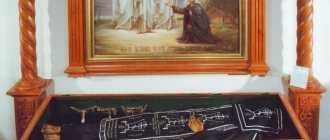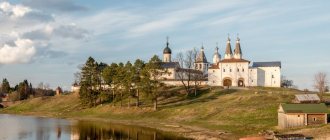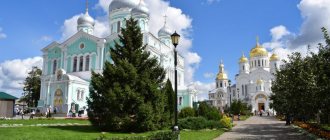Mir
Russia Pskov Region Spaso-Preobrazhensky Mirozhsky Monastery Map loading in progress...
{"format":"leaflet","minzoom":false,"maxzoom":false,"limit":50,"offset":0,"link":"all","sort":[""], "order":[],"headers":"show","mainlabel":"","intro":"","outro":"","searchlabel":"\u2026 \u0441\u043b\u0435\ u0434\u0443\u044e\u0449\u0438\u0435 \u0440\u0435\u0437\u0443\u043b\u044c\u0442\u0430\u0442\u044b","default":"","import-annotation":false,"width ":"auto","height":"350px","centre":{"text":"","title":"""link":"""lat":57.8051669999999973015292198397219181060791015625,"lon": 28.32928799999999824876795173622667789459228515625,"icon":""},"title":"","label":"","icon":"","lines":[],"polygons":[],"circles":[ ],"rectangles":[],"copycoords":false,"static":false,"zoom":8,"defzoom":14,"layers":["OpenStreetMap"],"image layers":[] ,"overlays":[],"resizable":false,"fullscreen":true,"scrollwheelzoom":true,"cluster":false,"clustermaxzoom":9,"clusterzoomonclick":true,"clustermaxradius":80, "clusterspiderfy":true,"geojson":"","clicktarget":"","showtitle":true,"hidenamespace":false,"template":"","userparam":"","activeicon": "","pagelabel":false,"ajaxcoordproperty":"","ajaxquery":"","locations":[{"text":"\u003Cb\u003E\u003Ca href=\"/palomnik/%D0% A1%D0%BF%D0%B0%D1%81%D0%BE-%D0%9F%D1%80%D0%B5%D0%BE%D0%B1%D1%80%D0%B0%D0%B6 %D0%B5%D0%BD%D1%81%D0%BA%D0%B8%D0%B9_%D0%9C%D0%B8%D1%80%D0%BE%D0%B6%D1%81%D0 %BA%D0%B8%D0%B9_%D0%BC%D0%BE%D0%BD%D0%B0%D1%81%D1%82%D1%8B%D1%80%D1%8C\" title= \u0421\u043f\u0430\u0441\u043e-\u041f\u0440\u0435\u043e\u0431\u0440\u0430\u0436\u0435\u043d\u0441\u043a\u0438\u0439 \u041 c\u0438\u0440\u043e\ u0436\u0441\u043a\u0438\u0439 \u043c\u043e\u043d\u0430\u0441\u0442\u044b\u0440\u044c\»\u003E\u0421\u043f\u0430\u0441\u043e-\ u041f\u0440\u0435\u043e \u0431\u0440\u0430\u0436\u0435\u043d\u0441\u043a\u0438\u0439 \u041c\u0438\u0440\u043e\u0436\u0441\u043a\u0438\u0439 \u043c\ u043e\u043d\u0430\u0441\u0442 \u044b\u0440\u044c\u003C/a\u003E\u003C/b\u003E\u003Chr /\u003E\u003Ca href=\»/palomnik/%D0%A1%D0%B2%D0%BE%D0%B9%D1 %81%D1%82%D0%B2%D0%BE:%D0%90%D0%BD%D0%BD%D0%BE%D1%82%D0%B0%D1%86%D0%B8%D1% 8F\" title=\"\u0421\u0432\u043e\u0439\u0441\u0442\u0432\u043e:\u0410\u043d\u043d\u043e\u0442\u0430\u0446\u0438\u044f\"\u003E\u04 10\u043d \u043d\u043e\u0442\u0430\u0446\u0438\u044f\u003C/a\u003E: \u043c\u043e\u043d\u0430\u0441\u0442\u044b\u0440\u0441\u043a\u043 8\u0439\u043a\u043e\ u043c\u043f\u043b\u0435\u043a\u0441 XIII \u0431\u043b\u0430\u0433\ u043e\u0434\u0430\u0440\u044f \u0435\u0434\u0438\u043d\u0441\u0442\u0432\u0435\u043d\u043d\u044b\u043c \u043d\u0430 \u0420\u 0443\u0441\u0438\u043f\u043e\ u0441\u0442\u0435\u043f\u0435\u043d\u0438 \u0441\u043e\u0445\u0440\u0430\u043d\u043d\u043e\u0441\u0442\u0438 \u0434\u043e\u0 43c\u043e\u043d\u0433\u043e\ u043b\u044c\u0441\u043a\u0438\u043c \u0444\u0440\u0435\u0441\u043a\u0430\u043c \u0441\u043e\u0431\u043e\u0440\u043d\u043e\u0 433\u043e\u0445\u0440\u0430\ u043c\u0430","title":"\u0421\u043f\u0430\u0441\u043e-\u041f\u0440\u0435\u043e\u0431\u0440\u0430\u0436\u0435\u043d\u0441\u043a\u04 38\u0439\ u041c\u0438\u0440\u043e\u0436\u0441\u043a\u0438\u0439 \u043c\u043e\u043d\u0430\u0441\u0442\u044b\u0440\u044c","link":"""lat":57.80 51669999999973015292198397219181060791015625, "lon":28.32928799999999824876795173622667789459228515625,"icon":""}],,"imageLayers":[]}
57.794214; 28.376783
Russia, Pskov urban district
Pskov region
Russia
Telephone.:
8(8112)576-403 (office).
Email:
Spaso-Preobrazhensky Mirozhsky Zavelichsky Monastery
- a monastery complex of the 12th century, famous for the only pre-Mongol frescoes of the cathedral church in Rus' in terms of state of preservation. It is located in Pskov, at the confluence of the Mirozha River (where it got its name) into the river. Velikaya, in the area called Zavelichye.
The ensemble is under state protection as a monument of republican significance (Resolution of the Council of Ministers of the RSFSR of August 30, 1960, No. 1327).
History[[edit]h2>
The exact date of foundation of the monastery is unknown. It is usually dated to the middle of the 12th century. and associated with the name of a Greek by birth, Saint Niphon, Bishop of Novgorod.
The monastery, located 20 minutes on foot from the Pskov region, was one of the cultural centers of the city, the Pskov chronicle was kept here, it had a library, a workshop of scribes (who copied, in particular, “The Tale of Igor’s Campaign”
), and an icon painting workshop. The monastery was rich. Its urban territory of the monastery occupied the entire floodplain of the river. Mirozhi (with mills), river bank Great with forges, utility yards, etc. After the secularization of church lands in the 18th century. its territories were reduced to their current size. The geographical location outside the fortifications of Pskov, which was often the target of attacks by Rus''s western neighbors, sometimes made the monastery a vulnerable target. Thus, in 1299, the Livonian knights, having ravaged the Pskov settlement, burned the Mirozhsky and Snetogorsky monasteries, and also killed Vasily Mirozhsky and the abbot of the Snetogorsk monastery, Joasaph, who were later canonized and became locally revered saints. According to legend, the relics of St. Abbot Vasily rests under cover in the altar of the Transfiguration Cathedral along with the relics of St. Abrahamia. At the beginning of the 16th century, the Venerable Martyr Cornelius of Pskov-Pechersky studied at the monastery (he took monastic vows at the Pskov-Pechersky Monastery).
In 1581, Stefan Batory installed cannons on the bell tower of the monastery, from which he fired at the city.
In 1567, under Ivan the Terrible, in the Mirozhsky monastery, the icon of the Mother of God, which received the nickname Mirozhsky, became famous for its miracles: the type of Oranta with the upcoming saints. Pskov Prince Dovmont and his wife Maria Dmitrievna.
According to the Brockhaus and Efron Encyclopedia
in the 19th century The monastery contained many ancient icons, the chalice of St. Nifont with the inscription 1166, gospel 1703, a silver ladle granted by Peter I to Pskovite Fadey Guryev, two bells from 1520 and 1521.
The monastery was abolished in the 20th century. After the revolution of 1917, the Pskov excursion station was located in the Mirozhsky monastery. Monastic life within the walls of the monastery began to revive in 1994, when the Church of the First Martyr Stephen, the fraternal building and the abbot’s house were transferred to the Pskov Diocese under a lease agreement. At the same time, the Mirozh international icon painting school was created, headed by Archimandrite Zinon (Theodore), one of the most famous modern icon painters. After allowing Catholics to serve in the monastery and receive communion with them, it was removed (see article). In 1997, His Eminence Bishop Eusebius consecrated the newly created icon painting school.
On May 1, 2010, the entire complex of buildings and territories of the monastery, with the exception of the Transfiguration Cathedral and small cells, was transferred to the Russian Orthodox Church for free use.
In 2011, an icon painting school for children in the city of Pskov began operating in the monastery.
Abbots
Abbots
- St. Abraham of Mirozhsky (c. 1156 - September 24, 1158)
- Isidore (1269)
- Prmch. Vasily Mirozhsky (+ March 4, 1299)
- Carp (mentioned 1404)
- Gregory (1521)
Archimandrites
- Mitrofan (1589)
- Herman (late XVI)
- Gennady (1617 - 1720)
- Gerasim (1623)
- Alexander (1630)
- Onuphry (in December 1630)
- Macarius (in December 1636)
- Arseny (1641)
- Jonah (1648)
- Mitrofan (? - 1650)
- Afanasy (1662 - 1670)
- Nikander (1673 - 1677)
- Gerasim (February 8, 1684 - 1691)
- Cornelius (1691 - 1699)
- Aaron (1702 - 1713)
- Cyprian
- Marcellus (1719 - 1720)
- Gerasim (1736 - 1744)
- Joasaph (Lisyansky) (1755 - 1761)
- Ioannikiy (1762 - 1763)
- Irinarch (1763 - 1768)
Abbots
- Stefan (1768 - 1774)
- Varlaam (Golovin) (1774 - 1775)
- Justin (Tripolsky) (July 20, 1774 - September 4, 1784)
- Adrian (1784 - 1786)
- Benedict I (1786 - 1792)
- Isaiah (1792 - 1796)
- Benedict II (Postnikov) (1796 - 1800)
Archimandrites
- Jacob (1800 - 1805)
- Arseny (1806 - 1818)
- Peter (Lavrov) (1818 - 1825)
- Anatoly, Vasily, Melchizedek, Hierome. and about
- Vitaly, Athanasius, Hierom. (1828 - 1830)
- Innocent, Hierom.
- Tikhon (ment. 1869 [7[7]hier. i/d
- Porfiry (mentioned 1891 - mentioned 1895 [1[13]hierom., i/d
Viceroys
- Zinon (Theodor) (1994 - 1996 [1[15]/li>
- Mark (ment. 2005 [1[16] October 6, 2007) Hierom.
- Nikolay (Bilichenko) (October 6, 2007 [1[17] 2017) abbot.
- Seraphim (Kozulin) (mentioned November 12, 2021 [1[18]/li>
Buildings[[edit]h2>
The oldest buildings of the monastery, except for the cathedral, have not survived. Currently, the ensemble of the Mirozhsky Monastery consists of: the Transfiguration Cathedral with an ensemble of fresco paintings (XII-early XX centuries), the Abbot's building (XVI-XIX centuries), Stephen's Church (XVII century), the Brethren Corps (late. XVIII-XIX centuries), monastic cells (XVII-XIX centuries), a monastery fence 400 m (1799-1805) and a bathhouse building (beginning of the 19th century).
Spaso-Preobrazhensky Cathedral of the Mirozh Monastery
Cathedral of the Transfiguration[[edit]h3>
Built of plinth and stone before 1156. This is a cross-domed temple, which has an architectural type unique to ancient Russian art. The central volume of the building has the shape of an equal-ended cross (its eastern branch is semicircular, as it ends with an altar apse), to which low compartments adjoin the corners: two rectangular ones in the west and two small apses in the east. Thus, initially the temple had a clearly defined cruciform shape on the outside. In the interior, the central cross-shaped space was connected to the corner spaces only by small passages. However, during the initial construction, superstructures were added over the western corners. Later the temple was rebuilt and its shape lost its original design. The architectural type of the cathedral served as a model for the Cathedral of the Nativity of the Blessed Virgin Mary of the Snetogorsk Monastery. The temple is one of the best examples of Russian architecture of the pre-Mongol period.
Painted from top to bottom in the 30s and 40s of the 12th century by unknown masters who came from Greece. The uniqueness of the frescoes lies in their high artistic quality, a well-thought-out iconographic concept, and also in the fact that almost the entire complex of paintings has been preserved. In style they have no chronological analogues in Russia and are reminiscent of Byzantine mosaics in some churches in Sicily of the same 12th century. The central position in the composition is occupied by the theme of the union of divine and human nature in God the Son and His atoning sacrifice; all the key moments of the temple decoration are subordinated to its disclosure. The culmination of the composition is the Deesis in the conch of the altar and the giant domed Ascension. The theme of the atoning sacrifice determines the content of the vaults and lunettes of the temple. Among this group of frescoes, the “Lamentation of Christ” (on the north wall) especially stands out. The third register from the top is dedicated to the miracles of Christ. The two lower registers of the main volume of paintings are reserved for the figures of holy prophets, warriors, presbyters, monks, etc. Inscriptions (in Greek) are rare, as a result of which the vast majority of images are not identified. Those identified include the warriors Sergius and Bacchus, the healers Panteleimon, Cyrus and John, the (rarely depicted) martyrs Romulus and Eudokios, the Persian saints Akepsimus, Aifalus and Joseph, the Venerables Nikon and Euphrosynus, and others.
In the 17th century, the frescoes were whitewashed, which fortunately contributed to their salvation. Through the efforts of archaeologist and art historian V.V. Suslov and his students, they were discovered from under the plaster at the end of the 19th century. The clergy of the monastery were not happy with the wear and tear of the paint layers and some lost areas. By decree of the Synod, V.V. Suslov was removed from the restoration, and for the “restoration” of the frescoes, an artel of Vladimir icon painters under the leadership of N.M. Safonov was hired, which in 1900-1901 washed the ancient paintings and then rewrote them “in the ancient style” , preserving only the ancient iconography of the plots. The new revelation of the frescoes began in the 1920s, but to this day approximately half of the area of the unique fresco ensemble is under the craftsman renovation of 1901. Nowadays, the Transfiguration Cathedral is a museum; services are not held in it.
Divine services in the Transfiguration Cathedral are held by the brethren of the monastery on certain holidays.
Bell tower, fraternal building and Stephen's Church
Temple of the Apostle and First Martyr Stephen[[edit]h3>
Stephen's Church is a gate temple on the basement. Built on the site of an older one, built in 1406. Very elegant, windows and doors are framed by columns, with interceptions and pediments. Regular services are held in the temple. The temple iconostasis is a unique fresco painting by Archimandrite Zinon. In addition, the temple contains a 1998 copy of the miraculous icon of the Mother of God of Mirozhskaya-Oranta, miraculously revealed in 1198. An older copy of the icon, dated 1583, is located in the Pskov State Museum-Reserve. In addition, among the revered shrines is the 19th century icon of the Great Martyr Panteleimon, brought from St. Mount Athos, the Tikhvin Icon of the Mother of God, Nicholas the Wonderworker, particles of the relics of many saints from all over the world. There are icon painting workshops at the monastery; Mirozh icon painters are continuers of the traditions of the Byzantine masters who painted the cathedral in the 12th century. In the basement of the Stefanovo Church there is an exhibition of modern icons. There is a refectory in the monastery building.
Current status and visiting hours
Nowadays, the monastery is a functioning Orthodox monastery, living according to strict monastic rules. Its territory is open to pilgrims and tourists daily from 8.00 to 19.00.
Divine services are held in the Church of the Apostle and First Martyr Stephen. Taking photos and videos is not prohibited here, however, travelers are asked not to take photographs of residents and church services.
For believers, there is a pilgrimage center that organizes excursions to the holy places of Pskov and the Pskov region. Male pilgrims can stay at the monastery for several days. Especially for them, the monastery has guest cells with amenities where up to five people can spend the night at a time.
Abbot's corps
A refectory has been opened in the Stefanovsky building. It is open from 10.00 to 12.00 and from 14.00 to 17.00. You can have breakfast, lunch and dinner here for a modest donation. The monastery church shop sells icons, souvenirs with views of Pskov sights, wax candles, books and films.
The monastery’s special pride is its icon painting workshop. The inhabitants of the monastery, who are professional artists, work here.
They work according to the traditional icon painting canon, created in the 12th century, and paint icons with tempera paints on linden boards, and use sheets of gold leaf for gilding. The monastery carries out many orders from other monasteries, temples and pilgrims. It is curious that the icon painting workshop offers special excursions and master classes for believers and tourists, where you can learn how to make wax candles and paint with egg tempera.
Shrines[[edit]h2>
The monastery contains the original icon of the Most Holy Theotokos “Mirozhskaya”
. Her appearance occurred in 1198. Almost four centuries later, in 1567, on the day of remembrance of the Monk Abraham, in the city of Pskov, during a raging pestilence, from this icon, as legend says, “the sacrament of our Lady, the Mother of God and the Ever-Virgin Mary, was performed of Her venerable sign: from the most pure image icons of tears from both eyes, like a stream, flowing, and a lot of thanksgiving and healing were received by a person from the image of the Mother of the Lord.” Then the icon was transferred from the Spaso-Preobrazhensky Cathedral of the Mirozh Monastery, “... and placed it in the cathedral church of the Holy Life-Giving Trinity near the altar... honestly, and from that time on, many and various healings began for the former man...”. Since then, in memory of the numerous benefits of the Mother of God revealed through Her holy image, a celebration was established in honor of the Mirozh Icon of the Mother of God on September 24.
Location
The monastery is located on the picturesque left bank of the Velikaya River, where the small river Mirozha flows into it. This is where the name of the monastery came from. If you focus on the Kremlin, then this object is located on the opposite bank of the Velikaya River, not opposite, but a little further (2.5 km from Krem, about 20 minutes on foot). If you go to the monastery on foot, the bridge offers magnificent views. In good weather you can see the Pskov Kremlin in the distance.
Panorama of the Velikaya River
Panorama of the Velikaya River
Icon of the Mother of God
In the Christian religion, they worship not only Saints, but also icons. The main holy relic of the local monastery is the icon of the Mirozh Mother of God.
It appeared in Pskov in 1198. This Christian phenomenon occurred on the Mirozhka River, on which a monastery was already located.
In 1596, during a mass infectious disease in the region, Pskovites came to the monastery. They prayed before the image of the Mother of God and received healing.
In connection with these healing properties of the icon, a service was written for the churches of Pskov and the date of celebration was determined (October 7). In 1922 the monastery was closed. Then the icon was transferred to the historical museum.
After the restoration of monastic life in the monastery, the shrine returned to its original place. Tourists can explore it by visiting the Church of St. Stephen the Apostle.
History of the city of Pskov
Historians have not established the exact year of foundation of Pskov. The first mention of this settlement dates back to 903 in the Laurentian Chronicle (the manuscript is named after the monk Laurentius). Therefore, it is customary to consider this date as the year of the founding of the city of Pskov. Its history begins precisely from this date.
In 1348, the medieval Pskov state was formed on the territory of Rus', which existed for 162 years. Its capital was Pskov.
Since 1510, the city was part of the Grand Duchy of Moscow, and until the 18th century it was one of the large cities of ancient Rus'.
The Pskov Fortress (2.5 km²), erected at one time, was a defensive fort of the western borders of the state, surrounded by five belts of stone fortress walls and was considered impregnable to external enemies.
Throughout its history, the Pskov defense structure, around which the city grew, was captured only once (not counting the occupation during the fighting during the First and Second World Wars).
This happened after the German crusaders, having ravaged Yuryev (a city founded by Yuri Dolgorukov in 1152), decided to capture Pskov. The city was occupied for 1.5 years, after which it was liberated by Russian troops under the command of commander Alexander Nevsky.
After the end of the Northern War (1700-1721) between Russia and its allies against Sweden, Pskov lost its defensive significance, since according to the treaty signed in the city of Nystad (Finland), the borders of the Russian Empire moved to the west.
The city became provincial in the Pskov province, and began its development in the 19th century. Residential wooden one-story houses were replaced by stone three-story buildings.
In connection with the development of the economy and trade with other cities of Russia, construction of the railway began in 1882. The St. Petersburg – Warsaw railway line was built through the city.
Interesting fact: at the Pskov railway station, built in 1860, in a royal carriage, Russian Emperor Nicholas II signed an act of abdication on March 2, 1917.
In 1904, the first power station was built, and 8 years later, tram traffic was opened in the city. During this period, healthcare, education, and the construction of church buildings and cultural institutions developed.
Now Pskov, home to more than 200 thousand indigenous people, is a modern, economically developed city that attracts history buffs with a large number of cultural monuments.
Diocese
The Pskov diocese was created in 1598, in gratitude for the defense of the western borders of Russia from the Polish troops of Stefan Batory. Until 1917, it carried out the construction of churches, monasteries, seminaries and many other church institutions on the territory of the Pskov province.
After the revolutionary events, the activities of the diocese were suspended. But it began to revive in 1945. Now, under the leadership of the diocese of the Pskov region, new religious institutions are being built and old churches and temples are being restored.
The diocese organizes church cultural and educational events and supports the development of Orthodox art. In Pskov, tourists can get acquainted with the life of members of religious communities and explore monastic monasteries: Pskov-Pechersky Monastery, Snetogorsky Convent, Krypetsky Monastery. The Mirozhsky Monastery is very popular among travel lovers.
Architectural monuments
The Mirozhsky Monastery is one of the most significant monuments of medieval architecture; in addition, it is the official symbol of the city of Pskov.
Important! The most ancient monument on the territory of the monastery is the Transfiguration Church. It surprises with its painting, performed by Byzantine masters specially invited for this purpose. The subject for the frescoes was scenes from the Holy Scriptures, both the Old and New Testaments, telling about the birth, life and death of Jesus Christ.
The emergence of the temple is associated with the name of Nifont, a Novgorod bishop who was Greek by origin, but took monastic vows in the Kiev-Pechersk Monastery. Nifont not only awarded the new monastery a name, but also developed a number of sketches for painting the walls of temples that are part of the architectural ensemble of the Spaso-Preobrazhensky Mirozhsky Monastery.
